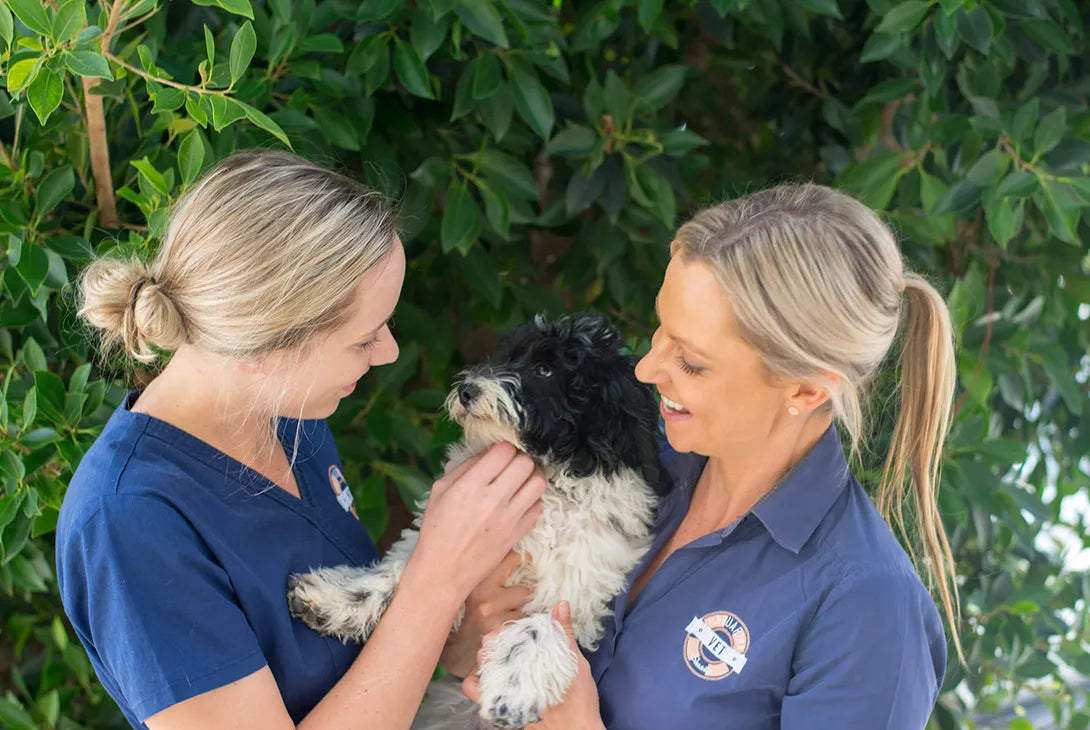As the season starts to change and we spend more time indoors you may be noticing more of your pet’s fur everywhere; on the couch, on the floor, clogging up the vacuum or even the dishwasher. So the question is, why does my dog shed so much hair? And what can I do about it?
There are several reasons that dogs shed fur. Some of them are normal such as seasonal shedding but some of them can indicate a health issue. There are definitely some clues that might suggest your dog has a medical issue and there are definitely some steps you can take to help reduce the amount of hair that falls out. But first, look at the reasons why dogs lose their hair.
 Out with the old and in with the new
Out with the old and in with the new
It’s very normal for your dog to shed fur. As new hair grows, the old or damaged hair follicles fall out. But just because it’s normal, that doesn’t mean there aren’t things you can do to help. More on this later.
Abnormal hair loss (alopecia) occurs when either there is damage to the hair follicle or a problem with the production of new hair. Damage to hair follicles can occur due to allergies, infections or even parasites. We’ve touched on allergies in the past and it’s a complicated story but in short, allergies in dogs can be caused by food, parasites and atopic dermatitis.
Infections which cause hair loss can be bacterial or fungal. They can invade secondary to allergies or can be picked up from the environment/other animals, including humans. (Think ringworm – gross!) Parasites such as fleas, mites and mosquitoes cause itching and as the hair follicles become damaged, the hair will fall out.
Poor hair production is generally due to something more concerning. Like a hormonal issue or serious underlying disease. The most common hormonal causes are Cushing’s Syndrome and Thyroid disease which we hear about in human medicine. Aside from hormonal causes, other underlying diseases such as liver or kidney problems and cancer can put the immune system under stress and cause hair loss.
Finally, some breeds can be born with or develop hereditary hair loss. We don’t see many of these in Australia but for example, if you have a lil’ Chinese Crested at home then you can stop reading now and perhaps go (dog) jacket shopping instead.
Signs that your dog is shedding too much
As I said, some shedding is normal but if you are noticing any of the following signs I would recommend a visit to your local vet. There are a range of steps your vet might want to take including gathering their medical history, and running some tests on their blood, urine and skin samples.
These signs include:
- Inflamed or abnormal looking skin
- Change in skin or fur colour
- Itching
- Bald patches
- Hair falling out in combination with other abnormal signs such as changes in appetite, thirst and weight.
If you are just not sure, then book a check-up to be safe.
What are we gonna do about it?
For plain ol’ normal shedding here are some tips to prevent your dog’s hair falling out.
 1. Brushing
1. Brushing
Brushing regularly helps to remove dead and damaged hair before it is shed into your dishwasher. (Ok, back-story here, once I caught my dog inside the dishwasher helping to ‘clean up’). Brushing also stimulates the production of natural oils which are protective and is a great opportunity to examine their skin and bond with your pooch. Different strokes for different coats - I’d suggest long bristles for a long coat and a stiffer bristle for a short coat. That’s why I like the Dr Zoo Grooming Brush. It has both types of bristles, and the stiffer bristle has nice smooth rounded pins.
2. Shampoo and Conditioner
As with brushing, shampooing with a natural dog shampoo will help to remove dead hair before it is shed and a good quality conditioner helps to strengthen the hair shaft to prevent damage and subsequent fur loss. It’s no secret that I love the Dr Zoo range for it’s wonderful smell and natural ingredients.
3. Diet
A good diet is important for overall health including the health of your dog’s skin and fur. Make sure that your dog’s diet is complete and balanced and if you want to give your dog’s fur some support, talk to your vet about adding in omega 3 and 6 fatty acids in the form of fish or fish oil. The idea here is to reduce shedding of dry, damaged hair. As well as a good diet always have plenty of freshwater available.
4. Parasite prevention
Fleas can be hard to see and mites are microscopic! The good news is most good flea treatments these days will cover mites as well. However, midges and mosquitos usually need a separate treatment so I’d suggest you add in Dr Zoo’s bug repellent for dogs.
All righty then! So, you’re sick and tired of your dog leaving its fur coat all around the house. There could be an underlying health issue that is causing your dog’s fur to fall out, so go through the checklist above and if you’re still not sure, have your pet examined at the vet. If it’s plain ol’ shedding, well, it ain’t going away so you’d better get to work on feeding a good quality diet, treating for parasites, brushing regularly and bathing that fur.
Xo Dogtor Andy
